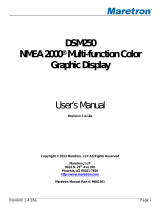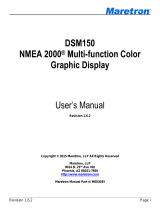Page is loading ...

Follow the safety precautions below to reduce
the risk of poor product performance, property
damage, personal injury, and/or death.
WARNING: Always wear safety goggles and a dust
mask when installing.
WARNING: The power supply must be OFF before
proceeding with the installation.
WARNING: A safe installation requires a 0.5 amp fast-
blow fuse or circuit breaker. Except WeatherStation
models with a heater require a 3 amp fast-blow fuse or
circuit breaker.
WARNING: The power source must be isolated from
the engine start battery(s). Voltage drops may cause
the instrument/receiver/sensor to lose information
and/or change operating mode.
IMPORTANT: Please read the instructions completely
before proceeding with the installation. These
instructions supersede any other instructions in your
instrument manual if they differ.
Tools & Materials
Safety goggles
Dust mask
Pencil
Electric drill
Drill bit: 3mm or 1/8"
Grommets (some installations)
Cutting pliers
Phillips screwdrivers
Wire strippers
Heat-shrink tubing
Heat gun
Slip-joint pliers
Multimeter
Cable Routing & Connecting Guidelines
CAUTION: To reduce electrical interference from other electrical
wiring and any on-board equipment with strong magnetic fields such
as radar equipment, radio transmitters, engines, generators, etc.,
separate the cables by at least 1m (3'). Ensure that all the cable
shields are appropriately grounded.
CAUTION: Be careful not to tear the cable jackets when passing
them through compartments, bulkheads, or walls. Use grommets
to prevent chaffing.
CAUTION: Use a multimeter to check the polarity and the
connections to the power supply before applying power to the
instrument/receiver/sensor.
Installation
Mounting Location & Hole Drilling
1. Select a convenient dry location for the water-resistant Splitter, a
minimum of 1m (3') from other cables and electronic equipment.
2. Hold the Splitter at the selected location and mark the position
of the four screw holes.
NOTE: If the Splitter will be mounted on a vertical surface, face
the compression nuts downward to avoid any possibility of
water seeping into the box.
3. At the marked locations, drill 3mm or 1/8" holes to a depth of
10mm (3/8"). Do not fasten the Splitter in place at this time.
INSTALLATION INSTRUCTIONS
NMEA 0183 and NMEA 2000
®
Splitter
For WeatherStation® Instrument
GPS Receiver
Heading Sensor
17-494-02 rev.03 02/27/13
Applications
The Splitter allows the data from the instrument/receiver/sensor
to be shown simultaneously on both an NMEA 0183 device and
an NMEA 2000 networked instrument.

10
Preparing the Cables
The Airmar Combination Cable is able to transmit data in both
NMEA 2000 and NMEA 0183 formats. The cable can be cut into
two parts (see Figure 1). The section with the sensor connector
becomes the sensor cable. The remaining section with the 7-pin,
NMEA 0183 connector becomes the NMEA 0183 cable.
Sensor Cable
1. Route the Combination Cable from the instrument/receiver/
sensor to the Splitter.
2. Allowing an extra 25cm (10") for wiring ease, cut the cable to
length. (Set the remaining section of the cable aside. It will be
used to connect the NMEA 0183 device to the Splitter.) Do not
connect the sensor cable or fasten it in place at this time
NMEA 0183 Cable
The remaining section of the Combination Cable will become the
NMEA 0183 cable.
1. Route this cable from the Airmar Data Converter, Airmar
Combiner, or NMEA 0183 instrument to the Splitter.
2. Allowing an extra 25cm (10") for wiring ease, cut the cable to
length. Do not connect the cable or fasten it in place at this time.
NMEA 2000 (Network) Cable (see Figure 2)
1. Route the NMEA 2000 cable from the network node to the Splitter.
2. Allowing an extra 25 cm (10") for wiring ease, cut the cable to
length. Do not connect the cable or fasten it in place at this time.
Connecting
1. Remove the cover of the Splitter. Set it aside along with the two
screws, the packet of silicone lubricant, and the bag of 6 x 1/2"
screws and butt connectors.
2. Following the label on the Splitter cover, push approximately
200mm (8") of each cable through the appropriate compression
nut (see Figure 3).
3. Strip 60mm (2-1/2") of the outer jacket and foil shielding from
the cut end of each cable (see Figure 4).
4. NMEA 0183 Cable Only (see Figure 5)
• Cut off the white and blue wires flush with the cable jacket.
• The black wire and the red wire will NOT be connected.
Cover the end of each wire with heat-shrink tubing to prevent
the possibility of a short circuit inside the Splitter. Use a heat
gun to shrink the tubing.
Figure 3. Inserting the cables into the Splitter
Copyright © 2008 - 2009 Airmar Technology Corp.
Figure 1. Airmar Combination Cable
Copyright © 2008 - 2011 Airmar Technology Corp.
1
2
3
4
5
6
7
NMEA 0183 connector
sensor connector
Figure 2. NMEA 2000 cable
Copyright © 2008 - 2011 Airmar Technology Corp.
NMEA 2000
network connector
Figure 4. Preparing the cables (sensor cable shown)
64mm (2 1/2")
remove cable jacket and
cable
jacket
foil shielding
heat-shrink
tubing
Copyright © 2008 Airmar Technology Corp.
2
compression
sensor
cable
NMEA 2000
(network)
cable
NMEA 0183
cable
nut (3)
locator
10
locator

10
1
2
3
4
5
6
7
5. Protect each cable’s foil shielding from causing a short circuit
inside the Splitter (see Figure 4). Use heat-shrink tubing around
the jackets where the wires emerge from the cable. The tubing
must overlap the wires a minimum of 6mm (1/4"). Use a heat
gun to shrink the tubing.
6. Make the connections using the red butt connectors supplied.
Insert the end of a colored wire into one of the holes in a butt
connector (see Figure 5). Insert the matching colored wire from
another cable into the opposite hole. (It is not necessary to
remove the colored insulation.) With the wires pushed tightly
against the far inside wall of the connector, squeeze the red
button until it depresses using slip-joint pliers. Gently tug on
each wire to ensure that it is securely fastened. Repeat this
process until all the wires are connected as shown in the wiring
diagram (see Figure 6).
NMEA 2000
Figure 6. Wiring diagram
NOTE: One of the butt connectors will be used to connect the
three bare wires. (Each connector has 3 holes to accommodate
up to 3 wires.)
NOTE: The red wire from the sensor cable will be connected to
the red wire from the NMEA 2000 cable. Likewise, the black
wire from the sensor cable will be connected to the black wire
from the NMEA 2000 cable. Do NOT connect the red and black
wires from the NMEA 0183 cable.
locator
NMEA 0183
Copyright © 2008 - 2011 Airmar Technology Corp.
Figure 5. Using the butt connectors
Copyright © 2008 - 2009 Airmar Technology Corp.
3
locator
butt
sensor cable NMEA 2000 cable NMEA 0183 cable
connector
NOTE: Do not connect
the red and black wires
from the NMEA 0183
red wire with
black wire with
NOTE: Insert the end of a
colored wire into one of the
holes in a butt connector.
Insert the matching colored
wire from another cable
into the opposite hole.
With the wires pushed tightly
against the far inside wall
of the connector, squeeze
the red button until it depresses.
NOTE: Do not connect
blue
cable.
heat-shrink tubing
heat-shrink tubing
network connector
sensor
connector
connector
10

Completing the Installation
1. From outside the Splitter, pull each cable until only 51mm (2") of
jacket remains inside the box. Using slip-joint pliers, tighten each
compression nut to make a watertight seal (see Figure 3).
2. Arrange the wires neatly inside the Splitter. Check to be sure
the gasket is firmly installed in the channel on the back side of
the cover (see Figure 7). Lubricate the gasket with the silicone
lubricant supplied. Screw the cover in place with the two long
screws supplied.
3. Fasten the Splitter in place with the four 6 x 1/2" screws
supplied in the plastic bag.
4. Plug the sensor cable’s connector into the sensor.
5. Plug the NMEA 2000 cable’s connector into the network.
6. Plug the NMEA 0183 cable’s connector into the Airmar Data
Converter or Airmar Combiner.
Connecting to an NMEA 0183 instrument
• Cut off the connector and discard.
• The white, blue, red, black, and bare wires are not needed.
Cut them off flush with the cable jacket.
• Protect the cable’s foil shielding from causing a short circuit
by covering the cable jacket with heat-shrink tubing where
the wires emerge from the cable. The tubing must overlap the
wires a minimum of 6mm (1/4"). Use a heat gun to shrink the
tubing.
• Connect the following wires:
grey A/+ NMEA output
purple B/- NMEA output
yellow A/+ NMEA input
orange B/- NMEA input
7. Fasten all the cables in place.
Parts
Obtain parts from your sensor manufacturer or marine dealer.
Gemeco Tel: 803.693.0777
(USA) Fax: 803.693.0477
email: sales@gemeco.com
Airmar EMEA Tel: +33.(0)2.23.52.06.48
(Europe, Middle East, Africa) Fax: +33.(0)2.23.52.06.49
email: sales@airmar-emea.com
NMEA 2000
®
is a registered trademark of the National Marine
Electronics Association.
AIRMAR
®
TECHNOLOGY CORPORATION
35 Meadowbrook Drive, Milford, New Hampshire 03055-4613, USA
www.airmar.com
Copyright © 2008 - 2013 Airmar Technology Corp. All rights reserved.
NOTE: Lubricate
the gasket with the
silicone lubricant
supplied
underside of cover
Figure 7. Lubricate the gasket
Copyright © 2008 - 2009 Airmar Technology Corp.
4
/



